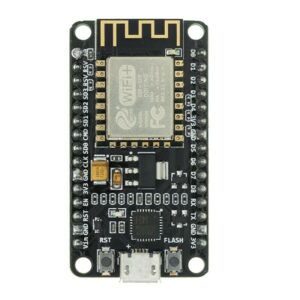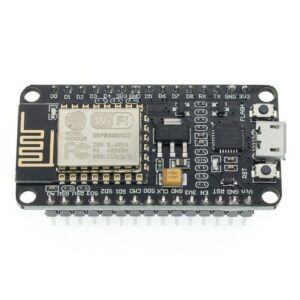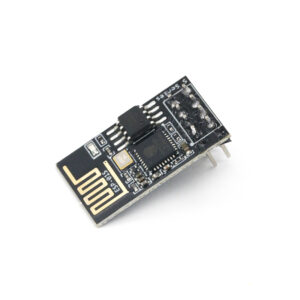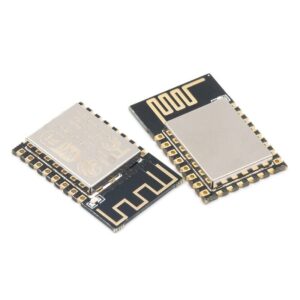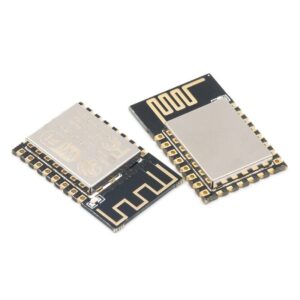ESP32 and ESP8266
Available modules at Kunkune ESP32 and ESP8266 are two popular WiFi and Bluetooth-enabled microcontroller boards. They are commonly used in IoT (Internet of Things) projects due to their low cost, compact size, and powerful capabilities.
Both ESP32 and ESP8266 are programmed using the Arduino IDE, which makes them easy to use for beginners and experienced developers alike. They also have a wide range of community-supported libraries and resources available, making it easy to find help if needed.
Showing 25–30 of 30 resultsSorted by price: high to low
Showing 25–30 of 30 resultsSorted by price: high to low
What Are ESP32 and ESP8266?
ESP32 and ESP8266 are popular microcontrollers widely used in Internet of Things (IoT) applications, leveraging Wi-Fi modules to provide wireless connectivity and offering extensive support for Arduino programming.
These microcontrollers stand out due to their versatility and compatibility with a wide range of IoT projects. The ESP32, for instance, is known for its dual-core processor, which allows for multitasking and high-performance applications.
Both the ESP32 and ESP8266 boast low power consumption, making them ideal for battery-powered devices in IoT ecosystems. Their support for Arduino IDE simplifies the development process, enabling developers to create and prototype projects quickly and efficiently.
What Are the Differences Between ESP32 and ESP8266?
Understanding the differences between ESP32 and ESP8266 is crucial for selecting the right microcontroller for your IoT projects, as both offer distinct specifications and functionalities.
Microcontroller
The ESP8266 features a single-core MCU chip, whereas the ESP32 is equipped with a dual-core MCU chip, offering enhanced processing capabilities.
One notable architectural difference between the ESP8266 and ESP32 lies in their CPU cores. While the ESP8266’s single-core design may suffice for simpler tasks, the dual-core setup in the ESP32 allows for more parallel processing, leading to improved performance in multitasking scenarios. This enhanced processing power makes the ESP32 a preferred choice for applications requiring simultaneous handling of multiple tasks or heavy computations.
Processing Power
The ESP32, powered by a dual-core Tensilica CPU, delivers superior processing power compared to the single-core CPU of the ESP8266.
This enhanced processing capability equips the ESP32 with the ability to handle more complex tasks and computations seamlessly, making it ideal for high-performance applications in IoT projects. The dual-core architecture not only boosts the device’s multitasking capabilities but also enhances overall performance by efficiently distributing processing load across the cores.
Whether it’s real-time data processing, running multiple algorithms simultaneously, or managing large datasets, the ESP32’s processing prowess ensures smooth operation even under demanding conditions. This enhanced performance opens up a broader range of possibilities for IoT developers, allowing them to create more sophisticated and responsive solutions.
Memory
In terms of memory, the ESP32 provides more RAM than the ESP8266, supporting more extensive and complex applications.
Having a larger memory capacity is crucial for scenarios that require multitasking, where the ESP32 outperforms the ESP8266 due to its increased RAM. With additional memory, ESP32 can handle concurrent tasks more efficiently, enabling smoother operation of multiple processes simultaneously.
Wi-Fi Capabilities
Both ESP32 and ESP8266 are equipped with robust Wi-Fi capabilities, making them ideal for wireless communication in IoT applications.
Regarding wireless protocols, the ESP32 stands out for its support of both Wi-Fi and Bluetooth, offering a wide range of possibilities for connecting devices seamlessly. On the other hand, the ESP8266 is mainly focused on Wi-Fi connectivity, which makes it a reliable option for projects requiring straightforward wireless communication.
In terms of wireless performance, the ESP32 generally outperforms the ESP8266 due to its advanced features and enhanced capabilities. The ESP32 can handle higher data rates and has better signal reliability, making it a preferred choice for more demanding IoT applications.
Bluetooth Capabilities
One of the significant advantages of the ESP32 over the ESP8266 is its integrated Bluetooth connectivity.
Regarding Bluetooth support, ESP32 offers various types such as Bluetooth Classic and Bluetooth Low Energy (BLE), making it versatile for different IoT applications. The BLE feature is particularly valuable for energy-efficient devices that need to transmit small amounts of data over long periods.
- For IoT projects, having Bluetooth connectivity opens up a plethora of possibilities, enabling seamless communication between devices without the need for complex wiring.
- Scenarios where Bluetooth is essential include smart home setups, wearable technology, health monitoring devices, and industrial automation systems.
What Are the Different Versions of ESP32 and ESP8266?
Several versions of ESP32 and ESP8266 are available, each offering unique features and improvements to cater to diverse development needs and project requirements.
ESP32-WROOM-32
The ESP32-WROOM-32 is a highly integrated module that combines Wi-Fi and Bluetooth capabilities with a rich set of GPIOs, making it suitable for a wide range of applications.
The module boasts dual-core processors with great power efficiency, enabling faster processing speeds for handling complex tasks. Its versatility makes it ideal for IoT projects, smart home devices, industrial automation, and wearable technology. One of the standout features of the ESP32-WROOM-32 is the low-power consumption, extending the battery life of devices it powers. Compared to its predecessors, this module offers improved performance and connectivity options, making it a top choice for developers looking to create connected solutions.
ESP32-S2
The ESP32-S2 is a single-core microcontroller with enhanced security features, designed to meet the needs of secure IoT applications.
Its unique security capabilities include a secure boot feature, flash encryption, digital signature, and cryptographic hardware acceleration. These features ensure that data integrity and confidentiality are maintained, making it ideal for applications requiring a high level of security.
Plus its security features, the ESP32-S2 boasts impressive performance metrics, with a CPU frequency of up to 240 MHz and support for Wi-Fi and Bluetooth connectivity. This combination of security and high performance makes it a versatile choice for a wide range of IoT applications, such as smart home devices, industrial monitoring systems, and wearable technology.
NodeMCU V2
NodeMCU V2 is a popular development board based on the ESP8266, known for its ease of use and support for Lua scripting.
One of its standout features is its built-in Wi-Fi capabilities, which make it ideal for IoT projects requiring wireless connectivity. The compact size of the NodeMCU V2 board also makes it versatile and easy to integrate into various projects.
Programming on the NodeMCU V2 is straightforward, thanks to the availability of the NodeMCU firmware that supports Lua scripting language. This simplicity appeals to beginners and experienced developers alike, allowing them to quickly prototype and develop IoT applications.
Typical projects that make use of the NodeMCU V2 include home automation systems, smart agriculture solutions, weather stations, and IoT devices for monitoring and control.
NodeMCU V3
NodeMCU V3 builds upon its predecessor with improved hardware and support for MicroPython programming, making it a versatile choice for IoT development.
When comparing NodeMCU V3 with its previous version, NodeMCU V2, developers will notice several enhancements that elevate the user experience. One key improvement is the upgraded flash memory capacity in NodeMCU V3, allowing for larger and more complex programs to be stored.
The improved analogue-to-digital converters (ADCs) in the V3 model provide more precise sensor readings, enhancing the accuracy of data collection. The enhanced power management system in NodeMCU V3 ensures efficient energy consumption, prolonging the device’s battery life.
What Are the Uses of ESP32 and ESP8266?
ESP32 and ESP8266 are extensively used in IoT applications, thanks to their versatile functionalities, ranging from sensors and modules to complex system integrations.
Internet of Things (IoT) Devices
ESP32 and ESP8266 are pivotal in the development of IoT devices, enabling seamless integration of sensors and modules whilst providing robust wireless connectivity.
These microcontrollers are widely used in various IoT applications, such as smart home devices, wearable technology, industrial automation, and agricultural monitoring systems. Their versatility and affordability make them a popular choice among developers and hobbyists, also the ease of use with breadboards.
For instance, the ESP32 can be utilised in smart thermostats to regulate home temperatures efficiently, whilst the ESP8266 is ideal for creating smart lighting systems that can be controlled remotely.
The benefits of using these ESP microcontrollers include low power consumption, small form factor, and compatibility with different programming environments. They also offer built-in Wi-Fi and Bluetooth capabilities, making it easier to connect IoT devices to the internet and other devices seamlessly.
Home Automation
In home automation, ESP32 and ESP8266 facilitate the creation of smart home systems by offering Wi-Fi and Bluetooth connectivity for various devices.
These microcontrollers play crucial roles in powering smart home ecosystems, enabling seamless communication between different components such as thermostats, lighting systems, security cameras, and smart appliances.
One of the key advantages of using ESP32 and ESP8266 in smart homes is their ability to efficiently manage power consumption, leading to energy savings and prolonged device lifespan.
Robotics
ESP32 and ESP8266 are widely used in robotics, offering extensive GPIO pins and development boards that simplify the integration of various robotic components.
The versatile nature of these microcontrollers enables them to be utilised in a wide range of robotic applications. For instance, they are commonly used in autonomous robots for navigation, object detection, and data processing tasks. One notable project that leverages the capabilities of ESP32 is the development of robotic arms for precise movements in manufacturing industries. By harnessing the efficiency and flexibility of these microcontrollers, engineers can design robots that perform complex tasks with accuracy and speed.
Wearable Technology
With their low power consumption and Bluetooth connectivity, ESP32 and ESP8266 are ideal for wearable technology applications.
These microcontrollers offer significant advantages in the realm of wearable tech. Their low energy usage ensures longer battery life for wearable devices, critical for continuous usage without frequent recharges. The ESP32 and ESP8266 enable seamless data transfer and communication through their Bluetooth capabilities, allowing wearables to connect with smartphones, other wearable devices, and the internet.
- One notable example of a wearable powered by the ESP32 is a fitness tracker. This device can track steps, heart rate, and sleep patterns while efficiently managing power consumption.
- Another application is smart clothing with ESP8266, which can monitor body temperature and adjust heating or cooling elements accordingly, enhancing comfort and health benefits.
How to Get Started with ESP32 and ESP8266?
- Getting started with ESP32 and ESP8266 involves choosing the right development board,
- installing necessary software, and
- beginning programming using platforms like Arduino IDE and MicroPython.
Choosing a Development Board
Choosing the right development board is essential, with options like NodeMCU V2, NodeMCU V3, and ESP32-WROOM-32 catering to various needs.
When selecting a development board, consider factors such as processing power, memory capacity, connectivity options, and compatibility with development tools.
- NodeMCU V2 is a cost-effective choice for IoT projects due to its built-in Wi-Fi capabilities.
- NodeMCU V3 offers improved performance and additional GPIO pins, making it versatile for a range of applications.
- ESP32-WROOM-32 stands out for its dual-core processor and Bluetooth support, ideal for more complex projects.
Each board has its strengths and limitations, so it’s crucial to match the features to the requirements of your specific project.
Installing the Necessary Software
Installing the necessary software, such as the Arduino IDE and relevant SDKs, is crucial for programming ESP32 and ESP8266.
Once you have downloaded the Arduino IDE from the official website, proceed with the installation by following the on-screen prompts. Make sure to also install the CH340 driver if you are using a development board with CH340 USB to Serial converter. After the IDE is installed, open it and go to the ‘Preferences’ menu. In the ‘Additional Board Manager URLs’ field, add the URL for the ESP board manager: https://dl.espressif.com/dl/package_esp32_index.json.
Programming with Arduino IDE
Programming ESP32 and ESP8266 with the Arduino IDE involves utilising various libraries to access the microcontrollers’ functionalities.
These libraries contain pre-written functions that simplify the coding process, allowing developers to focus on the specific tasks they want their microcontrollers to perform. By including these libraries in your code, you can easily interact with sensors, displays, motors, and other components that enhance the capabilities of your ESP32 and ESP8266 projects.
It is crucial to manage your libraries efficiently to prevent conflicts and ensure smooth integration. When selecting libraries, always consider their compatibility with your microcontroller and the functionalities they provide. Regularly updating your libraries to the latest versions helps in maintaining compatibility and accessing new features.
Troubleshooting Common Issues
Troubleshooting common issues with ES32 and ESP8266 often involves debugging code and ensuring proper hardware connections.
One of the first steps in resolving problems with these microcontrollers is to check the wiring connections to ensure they are secure and correctly placed.
Verifying that the code is properly uploaded and compatible with the specific board can help avoid potential issues. If encountering connection problems, make sure to check the power source and the baud rate settings.
Resetting the board and trying different USB ports can also sometimes resolve connectivity problems. It’s also recommended to consult online forums and resources for community-based support and troubleshooting tips.
Explore our audio board amplifiers, electronic components, Fnirsi oscilloscopes and relay modules.
Frequently Asked Questions
What is ESP32 WROOM32 and how is it different from ESP32 S2?
ESP32 WROOM32 and ESP32 S2 are both popular Wi-Fi and Bluetooth modules based on the ESP32 chip. However, ESP32 WROOM32 has more features and capabilities, such as a larger Flash memory and more GPIO pins, making it suitable for more complex projects.
What is NodeMCU V2 and how is it different from NodeMCU V3?
NodeMCU V2 and NodeMCU V3 are both development boards based on the ESP8266 chip. The main difference between them is that NodeMCU V3 has an upgraded USB-to-serial chip, making it more reliable and stable for programming and communication with the computer.
What is the main advantage of using ESP32 or ESP8266 for IoT projects?
The main advantage of using ESP32 or ESP8266 for IoT projects is their low cost and high functionality. These modules have built-in Wi-Fi and Bluetooth capabilities, making them ideal for connecting to the internet and controlling various devices and sensors.
What is the maximum range of Wi-Fi and Bluetooth connections for ESP32 and ESP8266?
The maximum range for Wi-Fi connections with ESP32 and ESP8266 is approximately 100 meters in an open space, while the maximum range for Bluetooth connections is around 10 meters. However, this range can be affected by obstacles and interference.
Can I use ESP32 and ESP8266 for home automation projects?
Yes, both ESP32 and ESP8266 are commonly used for home automation projects. With their Wi-Fi and Bluetooth capabilities, they can be easily connected to smart devices and controlled remotely.
What programming languages can I use for ESP32 and ESP8266?
You can use a variety of programming languages for ESP32 and ESP8266, including Arduino, MicroPython, and Lua. These languages are beginner-friendly and have a large community for support and resources.

